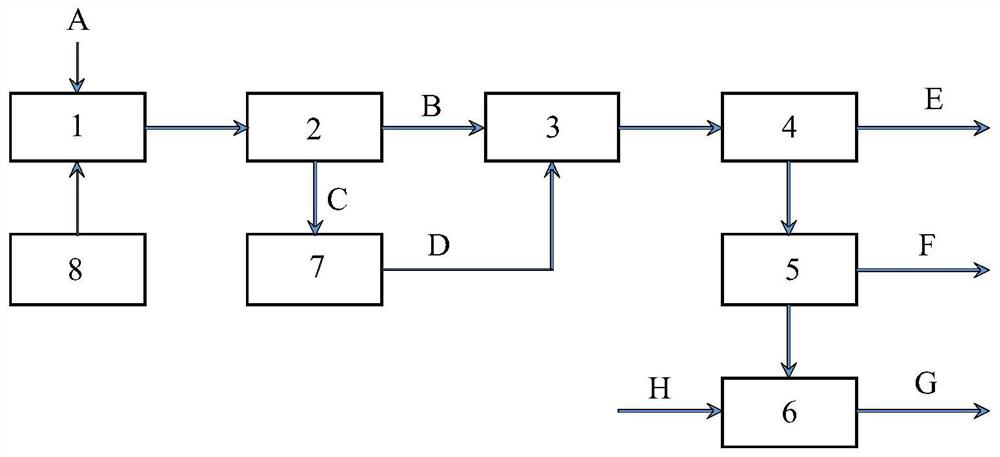Method for treating polymethoxydialkyl ether production wastewater
A technology for the production of polymethoxydialkyl ethers and waste water, which is applied in natural water treatment, water/sewage treatment, water/sewage multi-stage treatment, etc., and can solve the problems of difficult waste water treatment, high cost, waste of raw materials, etc. , to achieve the effect of reducing wastewater filtration accuracy, reducing raw material consumption, and reducing costs
- Summary
- Abstract
- Description
- Claims
- Application Information
AI Technical Summary
Problems solved by technology
Method used
Image
Examples
Embodiment 1
[0033] This embodiment provides a method for treating waste water from the production of polymethoxyl dialkyl ethers. body, the alcohol substance with a concentration of 25.74wt% and the aldehyde substance with a concentration of 14.75wt%; the alcohol substance is methanol; the aldehyde substance is formaldehyde.
[0034] The specific steps of wastewater treatment are as follows:
[0035] Step 1. Flocculation process: put polymethoxydialkyl ether production wastewater in a flocculation reactor, add flocculant, stir for 15 minutes and then let stand for 30 minutes. The flocculant is a mixture of polyaluminum chloride and cationic polyacrylamide, the added mass of polyaluminum chloride is 0.05‰ of the total mass of wastewater, and the mass of cationic polyacrylamide added is 0.08‰ of the total mass of wastewater.
[0036] Step 2. Standing process: standing and separating the substances after the flocculation reaction to obtain supernatant I and sludge sediment;
[0037] Step 3...
Embodiment 2
[0043] This embodiment provides a method for treating wastewater produced by polymethoxydialkyl ethers. The polymethoxydialkyl ethers are polymethoxydibutyl ethers, and the wastewater contains powders with a concentration of 95 mg / L, Alcohols with a concentration of 28.22wt% and formaldehydes with a concentration of 10.55wt.%; the alcohols are butanol; the aldehydes are formaldehyde.
[0044] The specific steps of wastewater treatment are as follows:
[0045]Step 1. Flocculation process: put polymethoxydialkyl ether production wastewater in a flocculation reactor, add a flocculant, stir for 15 minutes and then let it stand for 30 minutes to carry out a flocculation reaction. The flocculant is cationic polyaluminum chloride; the added mass of flocculant is 0.15‰ of the total mass of wastewater.
[0046] Step 2. Standing process: standing and separating the substances after the flocculation reaction to obtain supernatant and sediment;
[0047] Step 3. Filtration process: after...
Embodiment 3
[0053] This embodiment provides a method for treating waste water from the production of polymethoxydialkyl ethers. The polymethoxydialkyl ethers are polymethoxydiamyl ethers, and the waste water contains powders with a concentration of 92mg / L, Alcohols with a concentration of 30.17wt.% and formaldehydes with a concentration of 10.96wt.%; the alcohols include amyl alcohol; and the aldehydes are paraformaldehyde.
[0054] The specific steps of wastewater treatment are as follows:
[0055] Step 1. Flocculation process: put polymethoxydialkyl ether production wastewater in a flocculation reactor, add a flocculant, stir for 15 minutes and then let it stand for 30 minutes to carry out a flocculation reaction. The flocculant is polyferric sulfate; the added mass of the flocculant is 0.09‰ of the total mass of wastewater.
[0056] Step 2. Standing process: standing and separating the substances after the flocculation reaction to obtain supernatant and sediment;
[0057] Step 3. Fil...
PUM
 Login to View More
Login to View More Abstract
Description
Claims
Application Information
 Login to View More
Login to View More - R&D
- Intellectual Property
- Life Sciences
- Materials
- Tech Scout
- Unparalleled Data Quality
- Higher Quality Content
- 60% Fewer Hallucinations
Browse by: Latest US Patents, China's latest patents, Technical Efficacy Thesaurus, Application Domain, Technology Topic, Popular Technical Reports.
© 2025 PatSnap. All rights reserved.Legal|Privacy policy|Modern Slavery Act Transparency Statement|Sitemap|About US| Contact US: help@patsnap.com

